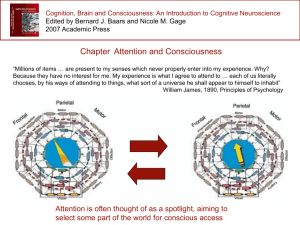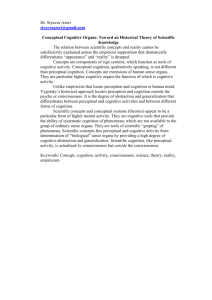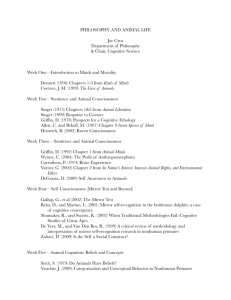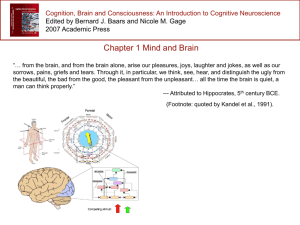executive - Baars and Gage
advertisement
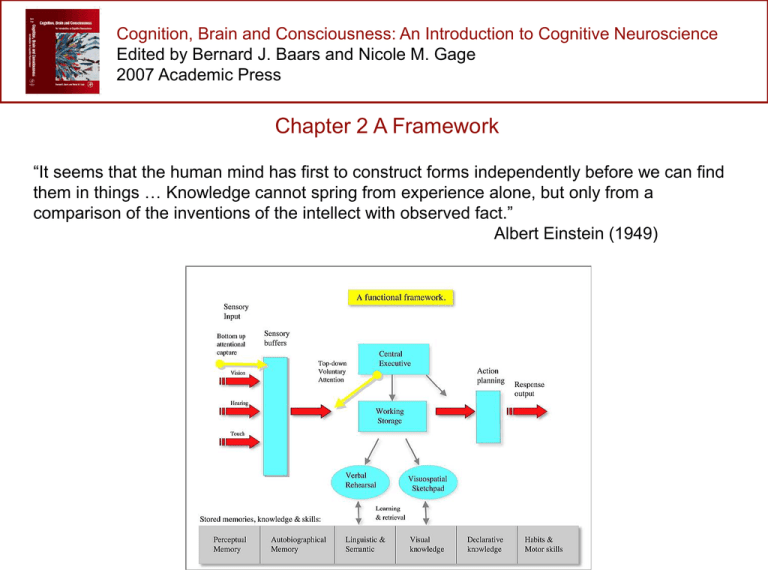
Cognition, Brain and Consciousness: An Introduction to Cognitive Neuroscience Edited by Bernard J. Baars and Nicole M. Gage 2007 Academic Press Chapter 2 A Framework “It seems that the human mind has first to construct forms independently before we can find them in things … Knowledge cannot spring from experience alone, but only from a comparison of the inventions of the intellect with observed fact.” Albert Einstein (1949) Cognition, Brain and Consciousness: An Introduction to Cognitive Neuroscience Edited by Bernard J. Baars and Nicole M. Gage 2007 Academic Press Chapter Outline 1.0 Introduction 2.0 Classical working memory 3.0 Limited and large-capacity functions 4.0 The inner and outer senses 5.0 The central executive 6.0 Action 7.0 Consolidation of short-term events into long-term memory 8.0 Summary Cognition, Brain and Consciousness: An Introduction to Cognitive Neuroscience Edited by Bernard J. Baars and Nicole M. Gage 2007 Academic Press 1.0 Introduction We use a functional framework to organize a good deal of cognitive neuroscience. While not all of the details are settled, it combines a large body of brain and psychological evidence into a single diagram. Cognition, Brain and Consciousness: An Introduction to Cognitive Neuroscience Edited by Bernard J. Baars and Nicole M. Gage 2007 Academic Press 1.0 Introduction Sensory information enters the system (left side of diagram), integrating with executive and memory systems on the way to output -- Action -- systems (right side of diagram). Cognition, Brain and Consciousness: An Introduction to Cognitive Neuroscience Edited by Bernard J. Baars and Nicole M. Gage 2007 Academic Press 1.0 Introduction A central goal of mind-brain science is to determine where the functions depicted on the framework diagram are processed in the brain. Cognition, Brain and Consciousness: An Introduction to Cognitive Neuroscience Edited by Bernard J. Baars and Nicole M. Gage 2007 Academic Press 1.0 Introduction Some major functions of the human cortex, color coded to show brain areas that support their processes. Top: a lateral view of the brain Bottom: a medial view at the midline Sensory information is processed in the posterior (back) half of the cortex Executive and motor functions occupy the frontal half. Cognition, Brain and Consciousness: An Introduction to Cognitive Neuroscience Edited by Bernard J. Baars and Nicole M. Gage 2007 Academic Press 2.0 Classical Working Memory Located in the center of the functional framework diagram, working memory systems interact with sensory input, executive function, long-term memories, and action systems The ‘inner senses’: below the working memory, two of the ‘inner senses’ are shown: verbal rehearsal and visuospatial sketchpad. These inner senses interact constantly with the long-term stores, shown in gray boxes on the bottom of the diagram. Cognition, Brain and Consciousness: An Introduction to Cognitive Neuroscience Edited by Bernard J. Baars and Nicole M. Gage 2007 Academic Press 2.0 Classical Working Memory Output functions include the central executive, action planning, and motor output, shown on the right side of the diagram. Cognition, Brain and Consciousness: An Introduction to Cognitive Neuroscience Edited by Bernard J. Baars and Nicole M. Gage 2007 Academic Press 2.0 Classical Working Memory Only a fleeting moment … the story of Clive Wearing, a rising young musician in Britain who was suddenly struck with a rare type of brain damage. In 1985, a viral infection destroyed regions of Clive Wearing’s brain, including both of his hippocampi. He was still able play the piano and conduct musical pieces that he knew before the injury, but could no longer learn new episodic (conscious) events. Wearing retains conscious events for only 10-20 seconds, living in an eternal present. His case has illuminated the role of the hippocampi in memory consolidation. Cognition, Brain and Consciousness: An Introduction to Cognitive Neuroscience Edited by Bernard J. Baars and Nicole M. Gage 2007 Academic Press 2.0 Classical Working Memory Only a fleeting moment … the hippocampi are critical to memory consolidation The two hippocampi, one in each cerebral hemisphere The red bulbs at the tips of the hippocampi are the amygdala, which play a fundamental role in emotion processing and emotional memory. Cognition, Brain and Consciousness: An Introduction to Cognitive Neuroscience Edited by Bernard J. Baars and Nicole M. Gage 2007 Academic Press 2.0 Classical Working Memory The case of HM -- bilateral surgical removal of the hippocampi The most studied memory patient is HM, who had both hippocampi removed in a surgery to relieve his epilepsy when he was a young man. The epilepsy symptoms ended, but HM had severe amnesia: he was unable to store new memories of his conscious life experiences (autobiographical memory), however he could learn new skills showing that his procedural memory formation was intact. A bottom view of the brain shows the regions removed by surgery for HM. Cognition, Brain and Consciousness: An Introduction to Cognitive Neuroscience Edited by Bernard J. Baars and Nicole M. Gage 2007 Academic Press 2.0 Classical Working Memory Understanding Clive Wearing in the functional framework diagram The case of Clive Wearing has provided evidence for the role of the hippocampi -- and the medial temporal lobe where they are located -- in cognition. Most functions are spared, however he has lost the ability to encode and retrieve conscious experiences. Cognition, Brain and Consciousness: An Introduction to Cognitive Neuroscience Edited by Bernard J. Baars and Nicole M. Gage 2007 Academic Press 2.0 Classical Working Memory The importance of immediate memory: immediate memory is needed for even the simplest of activities, like reading this sentence. You must be able to hold information during the few seconds it takes to read the entire sentence in order to understand its meaning. A similar storage process is required in visual processing: immediate memory is needed in order to integrate the small fixations that occur in vision. Long eye movements (saccades) jump from one point to another in the visual scene. The visual system must be able to hold this information in order to integrate and encode the visual image. Cognition, Brain and Consciousness: An Introduction to Cognitive Neuroscience Edited by Bernard J. Baars and Nicole M. Gage 2007 Academic Press 3.0 Limited and Large-Capacity Functions Even though the human brain has tens of billions of neurons, in some ways it has very narrow capacity limits … Limited capacity tasks Very large-capacity functions Dual input tasks Long-term memory Immediate memory limits Language vocabulary (+100,000 words) Ambiguous stimuli and meanings (necker cube, ambiguous words) Complex sensory and motor processes Competition between various features in a stimulus (Stroop task) Vast number of neurons, connections, and networks in the bran Cognition, Brain and Consciousness: An Introduction to Cognitive Neuroscience Edited by Bernard J. Baars and Nicole M. Gage 2007 Academic Press 3.0 Limited and Large-Capacity Functions Limited capacity tasks: dual task limits, Donald Broadbent, and his research on selective attention Can you pay attention to someone speaking into your right ear while another person is speaking into your left ear? What happens to your comprehension when your attention is divided? Groundbreaking studies were conducted by Donald Broadbent and others on the capacity limits of selective attention processes. Cognition, Brain and Consciousness: An Introduction to Cognitive Neuroscience Edited by Bernard J. Baars and Nicole M. Gage 2007 Academic Press 3.0 Limited and Large-Capacity Functions Limited capacity theory of Donald Broadbent Broadbent used a selective listening task, in which two messages are sent simultaneously to the two ears, to study the capacity limits of selective attention. Broadbent proposed a ‘funnel’ image of limited capacity functions that dramatizes the fact that our large brains have narrow limits for selective attention, conscious perception, and voluntary control. Cognition, Brain and Consciousness: An Introduction to Cognitive Neuroscience Edited by Bernard J. Baars and Nicole M. Gage 2007 Academic Press 3.0 Limited and Large-Capacity Functions Why are there such narrow capacity limits? Limited capacity tasks are associated with conscious experience while large-capacity functions are generally unconscious. Some scientists argue that capacity limits are due to the role of consciousness in combining numerous components of a very large brain into an integrated whole. Cognition, Brain and Consciousness: An Introduction to Cognitive Neuroscience Edited by Bernard J. Baars and Nicole M. Gage 2007 Academic Press 3.0 Limited and Large-Capacity Functions Measuring working memory: verbal and spatial memory tasks One way that visual working memory is assessed is by presenting visual shapes one at a time over specific time periods. Any stimulus may be presented and retested some seconds later to see if the subjects recalls the previous presentation. Cognition, Brain and Consciousness: An Introduction to Cognitive Neuroscience Edited by Bernard J. Baars and Nicole M. Gage 2007 Academic Press 3.0 Limited and Large-Capacity Functions Measuring working memory: ‘n-back’ tasks Another way that visual working memory is assessed is by presenting visual shapes one at a time over specific time periods and asking the subject to recall the item presented one, two, or three slides before. This is called an ‘nback’ task and is very demanding. Cognition, Brain and Consciousness: An Introduction to Cognitive Neuroscience Edited by Bernard J. Baars and Nicole M. Gage 2007 Academic Press 3.0 Limited and Large-Capacity Functions Measuring working memory: ‘n-back’ tasks Brain activity increases with working memory ‘load’, which is higher in 2- and 3-back tasks than in 0- and 1-back tasks Cognition, Brain and Consciousness: An Introduction to Cognitive Neuroscience Edited by Bernard J. Baars and Nicole M. Gage 2007 Academic Press 4.0 The Inner and Outer Senses What we see, hear, touch, taste, and smell (the outer senses) initially activate differing brain regions that then become integrated with the motor (action) system and other brain systems and processes Cognition, Brain and Consciousness: An Introduction to Cognitive Neuroscience Edited by Bernard J. Baars and Nicole M. Gage 2007 Academic Press 4.0 The Inner and Outer Senses What we see, hear, touch, taste, and smell (the outer senses) initially activate differing brain regions that then become integrated with the motor (action) system and other brain systems and processes The functional framework diagram, showing the sensory inputs to the brain Sensory systems tend to be located in posterior brain regions Cognition, Brain and Consciousness: An Introduction to Cognitive Neuroscience Edited by Bernard J. Baars and Nicole M. Gage 2007 Academic Press 4.0 The Inner and Outer Senses The mind’s eye, ear and voice: inner senses (for example, imagery) activate sensory regions in the brain a b c d Here is an example of a brain study where activation for perceived visual items (a) and imagined visual items (b) are quite similar. In fact, if you subtract brain areas activated for perceived stimuli from the imagined stimuli (c), almost no brain areas are active. The brain images are from the posterior portion of the brain (d) in visual cortex. Cognition, Brain and Consciousness: An Introduction to Cognitive Neuroscience Edited by Bernard J. Baars and Nicole M. Gage 2007 Academic Press 4.0 The Inner and Outer Senses Further evidence that the inner senses (for example, ‘talking’ to yourself) use brain processes that are very similar to those used for outer senses (such as speaking) is provided by experiments by Gary Dell and others who found that errors made in repeating tongue twisters were similar for inner (internally generated) vs. outer (spoken) speech. Try it yourself: repeat “Peter Piper picked a a peck of pickled peppers” silently to yourself as quickly as you can. Did you notice any errors? Was it difficult to do, despite the fact that your actual tongue was not involved in repeating this tongue twister (or was it?) Cognition, Brain and Consciousness: An Introduction to Cognitive Neuroscience Edited by Bernard J. Baars and Nicole M. Gage 2007 Academic Press 4.0 The Inner and Outer Senses Is there only one working memory? Investigators are researching whether there are working memory systems that are specific to a sensory system (such as vision), if there are systems that are non-specific/executive (a general temporary storage), or a combination of the two. Cognition, Brain and Consciousness: An Introduction to Cognitive Neuroscience Edited by Bernard J. Baars and Nicole M. Gage 2007 Academic Press 4.0 The Inner and Outer Senses Recent neuroimaging studies show evidence that there are differing brain areas that are activated during tasks that require differing types of working memory •The executive part of Working Memory involves the prefrontal lobe. •The verbal part -- such as rehearsing words silently --- involves speech areas (especially in the dominant hemisphere), e.g., Broca’s and Wernicke's areas. •The visual part --- such as visual imagery to think about how to walk from one place to another --- seems to involve visual regions, including the occipital lobe. Cognition, Brain and Consciousness: An Introduction to Cognitive Neuroscience Edited by Bernard J. Baars and Nicole M. Gage 2007 Academic Press 5.0 The Central Executive The prefrontal lobes play an important executive role in the brain. They are needed for voluntary control over actions. Prefrontal regions also support emotional processes and seem to be necessary to control one’s own unwanted impulses. "The frontal lobes are the latest achievements of the nervous system; it is only in human beings (and great apes, to some extent) that they reach so great a development. ... they lack the simple and easily identifiable functions of the more primitive parts of the cerebral cortex, the sensory and motor areas ... but they are overwhelmingly important.” -- Oliver Sacks, in Goldberg 2001 Cognition, Brain and Consciousness: An Introduction to Cognitive Neuroscience Edited by Bernard J. Baars and Nicole M. Gage 2007 Academic Press The prefrontal lobes play an important executive role in the brain. They are needed for voluntary control over actions. Prefrontal regions also support emotional processes and seem to be necessary to control one’s own unwanted impulses. "Thus in the famous case of Phineas Gage --- a railway foreman who while setting an explosive charge in 1848 had a two-foot tamping iron blown through his frontal lobes when the charge backfired --- while there was preservation of Gage's intelligence as well as his ability to move and talk and see, there were other, profound changes in him. He became reckless and improvident, impulsive, profane; he could no longer plan or think of the future; and for those who had known him before, "he was no longer Gage." He had lost himself, the most central part of his being, and (as is the case with all patients with severe damage to the frontal lobes), he did not know it". -- Oliver Sacks, in Goldberg 2001 Cognition, Brain and Consciousness: An Introduction to Cognitive Neuroscience Edited by Bernard J. Baars and Nicole M. Gage 2007 Academic Press 5.0 The Central Executive Are there different brain areas involved for voluntary vs. automatic movements? The evidence supports the notion that movements that are automatic engage different regions than those that require executive effort. On the left, this brain damaged patient cannot produce a voluntary smile. On the right, this patient can smile when presented with a funny image. Frontal lobe damage impaired her executive control of smiling movements but not the automatic response of a natural, spontaneous smile. Cognition, Brain and Consciousness: An Introduction to Cognitive Neuroscience Edited by Bernard J. Baars and Nicole M. Gage 2007 Academic Press 5.0 The Central Executive Executive attention networks in the cortex What brain areas are active during selective attention? Posner proposed that an executive attention network includes regions in parietal and prefrontal cortex. Cognition, Brain and Consciousness: An Introduction to Cognitive Neuroscience Edited by Bernard J. Baars and Nicole M. Gage 2007 Academic Press 5.0 The Central Executive The task in ‘a’ and ‘b’ is to search for a horizontal green bar. In a, the green bar appears to ‘pop-out’ spontaneously, while in b, finding the green bar requires effortful search. This type of task is used to investigate brain regions involved in voluntary attention under executive control vs. spontaneous attentional capture. Cognition, Brain and Consciousness: An Introduction to Cognitive Neuroscience Edited by Bernard J. Baars and Nicole M. Gage 2007 Academic Press 5.0 The Central Executive The functional diagram shows a hypothesized relationship between selective attention and conscious events. A number of scientists believe that selective attention may be needed for conscious sensory experiences. Cognition, Brain and Consciousness: An Introduction to Cognitive Neuroscience Edited by Bernard J. Baars and Nicole M. Gage 2007 Academic Press 6.0 Action The last elements of the functional diagram involve output: control of voluntary actions. On the output side, the motor system is proposed to be structured with a processing hierarchy beginning with general goals, influenced by emotional and motivational input, proceeding to more specific motor plans and maps. Cognition, Brain and Consciousness: An Introduction to Cognitive Neuroscience Edited by Bernard J. Baars and Nicole M. Gage 2007 Academic Press 7.0 Consolidation of short-term events into long-term memory Long-term stores are shown in the functional framework diagram along the bottom, ranging from perceptual memory to highly practiced habits Cognition, Brain and Consciousness: An Introduction to Cognitive Neuroscience Edited by Bernard J. Baars and Nicole M. Gage 2007 Academic Press 7.0 Consolidation of short-term events into long-term memory If information is retained over a period of seconds to hours, it may become permanent or ‘consolidated’. A good night’s sleep is now known to facilitate memory consolidation. In this way, transient, short-term memories become consolidated into stable, long-term memories over time. Short term memories are subject to interference, probably because they involve active neuronal circuits in the brain. Cognition, Brain and Consciousness: An Introduction to Cognitive Neuroscience Edited by Bernard J. Baars and Nicole M. Gage 2007 Academic Press 7.0 Consolidation of short-term events into long-term memory Long-term memory functions are widely distributed throughout the brain. According to the consolidation hypothesis put forward by Fuster, memories are stored in many different regions of the brain. For example, perceptual memory involves perceptual regions, while executive memory, such as plans for future actions, engage frontal regions . Cognition, Brain and Consciousness: An Introduction to Cognitive Neuroscience Edited by Bernard J. Baars and Nicole M. Gage 2007 Academic Press Chapter Summary A broad functional framework for cognitive neuroscience is presented, based on widely accepted ideas from cognitive psychology •Immediate memory seems to depend on the medial temporal lobe, including the two hippocampi. Damage to these regions impairs the ability to transfer information from the present moment to long-term storage. •The posterior half of the cortex is involved in sensory processes and probably also in sensory-perceptual memory. •The front half of the cortex is involved with motor and executive functions, and probably also with long-term memory needed for those processes. Cognition, Brain and Consciousness: An Introduction to Cognitive Neuroscience Edited by Bernard J. Baars and Nicole M. Gage 2007 Academic Press Chapter Summary •Selective attention has been studied for some fifty years and, in the past 15 years, the traditional question of conscious experience has again come to the fore •There is an ongoing debate about the meaning of terms like ‘working memory’, ‘attention’ and ‘conscious experiences’. Such debates are common in science. •There has been a wealth of new knowledge learned about human cognition and the brain. It is an intricate business to tease apart these aspects of human thought and action experimentally. While the field has made progress in understanding how these areas of cognition interact, we have far to go before we will have a clear understanding of the dynamic integrative and interactive processes that underlie the human condition.

